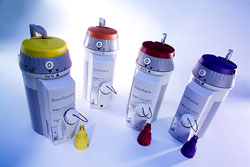The Dräger Vapor turns 50

Vapor's today
When the surgeon gives the go-ahead signal, it means that an additional painful phase in the surgery is about to begin. The anesthetist then turns the handwheel on the Vapor to reinforce the patient’s anesthesia. The anesthesia machine or an anesthesia gas monitor shows the relevant readings, i.e. that the concentration of the anesthetic in the inspiratory and expiratory gas is correct.
A look backward
Anesthesia administration was not always as precise; its introduction in 1846 made ether the most popular preparation. But new technologies and alternative liquid anesthetics emerged in the mid 20th century. Halothane conquered the market and soon the demand for a new precise dosing technique emerged. In 1958 Dräger came out with the Vapor, a calibrated dosing device that is attached to the anesthesia device and through which fresh gas is supplied.
The Vapor adds the anesthesia dosage and concentration defined and set by the anesthetist to the fresh gas. Although the dosing (bypass) mechanism used by the Vapor has changed very little, the device’s technology is continuously optimized.
The Dräger Vapor: synonymous with quality
One of the most outstanding features of the Dräger Vapor is that it never has to be recalibrated. Thus Vapor users can rest assured that the device will always deliver the exact dose defined by the anesthetist. The special stainless steel and brass alloys used in the Vapor allow for a long service life, resistance to alteration, and pressure and temperature compensation. Other features of the Vapor include its bypass mechanism, which is adjusted down to the micrometer level, and the fact that the dosage area is free of aluminum, which might react with the anesthetic.
The Vapor is transportable and can be refilled using standard bottles
Five main types of liquid anesthetics are utilized today: sevoflurane, desflurane, enflurane, halothane and isoflurane. Although these substances are used various ways according to clinical indication, each needs its own Vapor.
This means that the vaporizer must be moved from place to place within the hospital in a sealed state. To this end, the Dräger Vapor integrates a patented transport setting using a handwheel and that hermetically seals the vaporizer – before it had to be emptied every time.
Even if only a minute of anesthetic remains in the Vapor, the vaporizer’s 300 ml tank accommodates standard 250 ml refills, thus virtually eliminating wastage.
Special Applications
The Dräger Vapor can be used in conjunction with a Fabius MRI anesthesia unit if as patient must be sedated for an MRT scan. The Vapor is interoperable with 1.5 and 3 tesla MRT systems.
The Vapor output remains stable within physician-defined anesthesia dosage at temperatures ranging from 10 to 40 °C. This is particularly important for bone surgery, where an OR temperature of 15 °C is maintained, or for surgery on burn victims, for which the OR temperature must be raised.
In addition to anesthesia applications, the Vapor is also used by pharmaceutical companies to market their anesthetics, as well as by other anesthesia device vendors.
About Dräger
Drägerwerk AG & Co. KGaA is one of the international leaders in the fields of medical and safety technology: Dräger products protect, support and save human life. Founded in 1889, in 2007 the Group achieved sales of 1,819.5 million Euro worldwide and an EBIT of 151.9 million Euro. Today, Dräger employs around 10,000 people in more than 70 subsidiaries worldwide and has representation in around 190 countries. The Dräger Medical subsidiary offers products, services and integrated system solutions which accompany the patient throughout the care process – Emergency Care, Perioperative Care, Critical Care, Perinatal Care and Home Mechanical Ventilation.
Contact for Trade Press:
Birgit Diekmann
Tel.: +49 451 882 1215
E-mail: birgit.diekmann@draeger.com
Media Contact
More Information:
http://www.draeger.comAll latest news from the category: Corporate News
Newest articles

NASA: Mystery of life’s handedness deepens
The mystery of why life uses molecules with specific orientations has deepened with a NASA-funded discovery that RNA — a key molecule thought to have potentially held the instructions for…

What are the effects of historic lithium mining on water quality?
Study reveals low levels of common contaminants but high levels of other elements in waters associated with an abandoned lithium mine. Lithium ore and mining waste from a historic lithium…

Quantum-inspired design boosts efficiency of heat-to-electricity conversion
Rice engineers take unconventional route to improving thermophotovoltaic systems. Researchers at Rice University have found a new way to improve a key element of thermophotovoltaic (TPV) systems, which convert heat…



